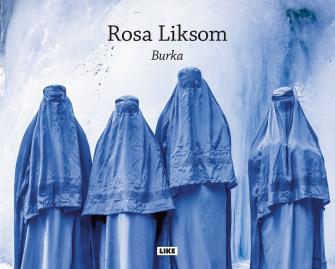Burka 2014, LIKE
Rosa Liksom
Burka
Kustantaja / Publisher: Like (2014)
Rosa Liksomin kuvissa kansallismaisemissamme, merenrannoilla, lähiössä ja joutomailla sinisissä burkissa vaeltavat hahmot avaavat yllättäviä näkökulmia maailmaan, jonka luulemme tuntevamme ennalta. Burkan sininen väri on sama kuin Suomen siniristilipussa. Näkökulma on yllättävä, tuttu maisema näyttää yhtäkkiä toiselta, hunnutetut naiset ovat siinä kuin kotonaan. Yhteensopimattomien symbolien yhdistelmä herättää tunteita, ajatuksia ja kysymyksiä. Voiko burkaan suhtautua neutraalisti, onko se uhka länsimaiselle vapaudelle vai lupaus jostakin, maailmasta erilaisuuksien kohtauspaikkana?

In the winter of 2005 I began preparing for an exhibition at the Cupido Gallery in Stockholm’s old town. The theme of the exhibition was the Finnish national landscape. I painted landscapes in the postmodern spirit, in the same places where the artists of Finland’s golden age, from Pekka Halonen to Akseli Gallen-Kallela, painted works that strove toward an independent identity for Finland. I wanted to incorporate media arts and photographs into the exhibition as well. I decided to photograph that same landscape, but I needed a defamiliarizing element in my photographs, something that would bring the present into the landscape and at the same time be mysterious and unexpected. I remembered the vegetable market in Copenhagen’s Nørrebro district where I used to shop every Saturday. Most of the customers at the market were immigrants and the majority of the women dressed in a variety muslim women’s dress, including blue burkas, which became a familiar sight for me. I chose an Afghan style blue burka for my project because the color is the same as the blue cross on the Finnish flag.
It’s a burka with a twist in it, and some humor. It’s visually interesting because it sometimes reduces to a purely graphic element, a shape, even just a texture, and at other times it reaches out and reveals in a surprising way. Northern nature looks different when there’s a burka in the middle of it. This juxtaposition awakens feelings, thoughts, and questions.
At the beginning of the project I collaborated with photographer Kari Pullinen, but later on I started making photos myself, for practical reasons.
My work with the burka has broadened over the years and I’ve also photographed myself in a burka on my travels to all the countries where translations of my books have taken me. The project is still ongoing, living and breathing and varying from one place to the next.
Rosa Liksom (Translation Lola M. Rogers)
Rosa Liksom’s burka photographs open up a surprising view of a world that we think we already know. The veiled figures presented in the pictures are wandering on green forest paths, in sublime national landscapes, in quite churchyards, on sea shores, in neighborhoods and wastelands, and we’re sure to ask, as if driven by some inner compulsion, What in the world are the these denizens of hot, dry Arab countries doing in places that belong culturally to us? Is the burka in the picture a threat, or a promise of something? And could women born into extremist muslim societies really be like that – free citizens of the world who feel at home in a variety of places and landscapes?
The women Liksom photographs are active and always traveling, as if they really had found a way to break out of the limitations of the fundamentalist culture of their birth and begin to live as they pleased – without giving up their burka. When they arrive in new places these wanderers go about their business like nothing unusual has happened, as if the whole world was equally their home. This point of view is arresting and also changes us, the viewers of Liksom’s photos. By using this artfully created duality of perspective, causing us see both our own presuppositions and the cultural possibilities of globalization, the artist coaxes to us to create a space for a new kind of “third” identity and to better inhabit the earth. Borrowing from current globalization research, this sort of artistic practice could also define new types of creative work in de-territorialized ethnolandscapes, landscapes where an effort is made to create living space for various cultural othernesses and previously unseen forms of coexistence not based on nationality.
In linking mutually exclusive cultural symbols and codes like the burka, nature walk, and northern European landscape, Liksom also subtly fixes our attention on how vague and open to reinterpretation the relationships between “us” and “them” always are. The radiant beauty, peace, and harmony of the photos provides a buffer for this process, allowing these foreigners to change the places where they wander with their presence. But Liksom doesn’t aestheticize multiculturalism or build utopias. Rather, she examines present-day reality as an exciting meeting place for differences, where we encounter a never-ending negotiation with the history of human community, the present, and the past.
The burka project is also a kind of visual diary. Liksom took the photographs in the series beginning in 2005, working steadily both in her own neighborhood and on her travels, and appears herself in many of the photos wearing a burka. So the photos also record the artist’s own life and above all the places that have allowed her a moment to breathe within them or to move past, or through, herself.
Anita Seppä, Professor, University of the Arts, Academy of Fine Arts (Translation Lola M. Rogers)


